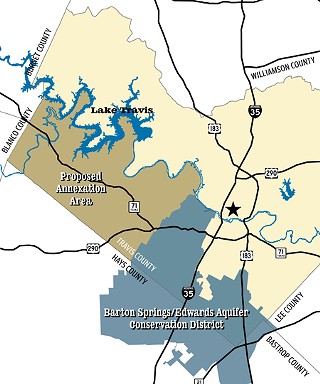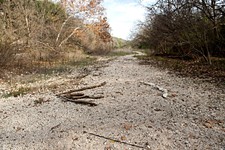Aquifer Board Seeks to Expand Its Regulatory Reach
Groundwater agency wants to tighten its grip in western Travis County
By Jacob Cottingham, Fri., Sept. 19, 2008

The Barton Springs/Edwards Aquifer Conservation District may be riding to the rescue of western Travis County, where residents are watching their wells run dry with greater frequency – thanks to rampant Hill Country growth and unregulated groundwater pumping. Currently, the Wild West mindset of "right to capture" is the law of the land in any areas outside a groundwater conservation district. The BS/EACD seeks to change that theory in this particular area of the county with an annexation proposal as soon as next year's ballot.
Right of capture allows anyone with a well the right to draw water from the aquifer without any regulation or legal obstacles concerning the pumping's impact on neighbors. Such rules cause all sorts of hardship. Tecolote Organic Farm, northeast of Austin, recently had two of its wells dry up when legal pumping next to the farm seemingly sucked dry its localized aquifer. While many developers in western Travis Co. have access to surface water lines provided by the Lower Colorado River Authority, the LCRA's water contracts do not prohibit developers from pumping aquifer water to feed amenities such as community ponds or other water features.
As part of a long-range regional water-use plan, the state of Texas authorized the creation of five Priority Groundwater Management Areas, the largest of which is the nine-county Hill Country PGMA. These specialized areas are "experiencing, or [are] expected to experience, within 25 years, critical groundwater problems including shortages of surface water or groundwater ... and contamination of groundwater supplies," according to the Texas Commission on Environmental Quality website.
The Hill Country PGMA is centered around the Trinity Aquifer and includes portions of Travis and Hays counties. The regulations also stipulate that a PGMA must have its entire area covered by a groundwater conservation district, such as the BS/EACD or the fairly new Hays Trinity Groundwater Conservation District. Because western Travis Co. is within the PGMA but outside of a conservation district, it represents a hole in the regulatory coverage. Despite its "critical" status, no entity is managing the territory, setting up the county for a nasty surprise in the coming decades.
Although the TCEQ consulted several groundwater conservation districts about incorporating the area, BS/EACD General Manager Kirk Holland says his agency is best situated to take over stewardship of the area. "We probably have more resources available to make that happen from a standpoint of staff and financial wherewithal," he said.
Residents south of Lake Travis and the Colorado River and west of the current boundaries of the BS/EACD generally have little access to surface water, with the exception of recent arrivals residing in new subdivisions. "The Trinity is the major aquifer and generally the only aquifer for the rural folks to utilize," says Holland.
The BS/EACD board is generally supportive of the annexation, though it has yet to formally vote on the matter. Travis County commissioners and the LCRA also appear to be warming to the idea, although an LCRA spokeswoman issued this response to a Chronicle query: "While LCRA promotes water-management practices that help ensure enough water to meet the region's needs, LCRA does not have a position on the annexation at this time."
A groundwater conservation district could regulate the construction of new pumps and establish management practices for larger, existing pumps. A conservation district "will be a force for education for water conservation and drought management," Holland says. It "will allow additional scientific studies of aquifers in the area and can remove some of the uncertainty associated with the hydrogeologic setting and enable us to be better protectors of water quality and quantity in the area." He also added that citizens in the proposed annexation area would have "more effective participation in the regional groundwater planning process." He indicated that a district would protect property values by preserving pumping and ensuring that pumps wouldn't serve as conduits for pollution from the surface.
Before an annexation can move forward, voters in the proposed area must approve the proposal, which should pass easily, judging from residents' calls for tighter regulation. Such an election could happen as soon as May, and the BS/EACD is already planning information sessions in the potentially affected communities. Holland said opponents of the measure are "philosophically inclined" against further government involvement in their lives. Holland stressed that water users would not see a spike in their pumping fees and that the BS/EACD was seeking a "golden path" by which it could add the territory without taking on expenses greater than it could afford.
If voters fail to ratify the proposal, the TCEQ would be legally compelled to create a new groundwater conservation district to cover the area – and in that case would likely levy taxes on all groundwater users in the affected area. Thus, annexation would seem to be the best financial and environmental choice. Says Holland: "I think our board almost considers us something of a white knight to these folks."
Got something to say on the subject? Send a letter to the editor.










